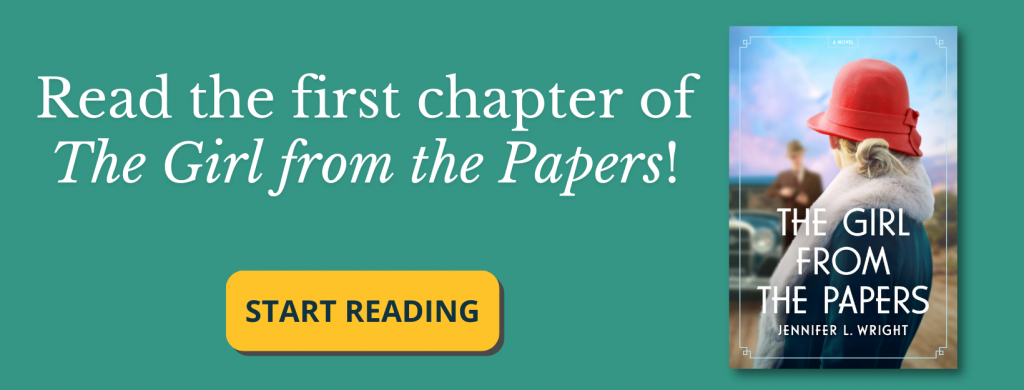In this article by author Jennifer L. Wright, Jennifer takes us behind the scenes to tell us how research for her first book and a simple conversation led to the inspiration behind her latest historical release, The Girl from the Papers! Read what Jennifer has to say about her unique twist on a Bonnie and Clyde story.
The Girl from the Papers was a book I never intended to write.
Although I’d of course heard of the infamous outlaws Bonnie Parker and Clyde Barrow, my first real encounter with them came during the research phase of my first novel, If It Rains. Because it was set during the Great Depression, I dove into all things 1930s in hopes of creating a truly authentic backdrop to the story. Economic turmoil, dust, starvation, mass migration—there was no shortage of complex issues with which to color the era. So much so, in fact, that there was no way I could work every single historical tidbit into my novel without it seeming overwhelming.
Because of this, I began writing articles on my blog both expounding on some of the historical background I’d touched on in the book and also talking about the information I’d come across during my research that I’d found interesting but had no space to include within the novel’s pages. One of these articles, published in March 2019, was called “Suicide Sal and the Barrow Gang.” In it, I touched on the so-called Public Enemy era of the Great Depression, during which criminals such as Bonnie and Clyde were regularly splashed across the front pages of newspapers, their crimes met with equal measures of fear and fascination. It was a fascinating story, for sure, but not one to which I gave much thought past that initial post.
Until a fateful phone call with my editor.
After the publication of If It Rains, I had a meeting with my editorial team to discuss my next book, Come Down Somewhere, and any additional story ideas I might have up the pipeline. When I confessed I hadn’t really begun to think about the next book, we began brainstorming, and one of the editors mentioned the blog post I’d written about Bonnie and Clyde.
“It was very compelling,” she said, “and I think it would make a great story. But I’m not sure you could work a faith element or redemptive arc into a book like that.”
Have I ever mentioned how I take challenges—even if they’re not direct—personally?

Wanting to see if I could, in fact, turn a story about a pair of criminal lovers into a God-glorifying novel, I did a deep dive into the lives of Bonnie and Clyde. I read every book I could get my hands on, devoured several documentaries, and even watched the old Faye Dunaway and Warren Beatty dramatization of their lives. And, frustratingly, my editor was right: their story was nothing short of a tragedy. Two kids, growing up in a harsh, poverty-choked world, turn to a life of crime to get the things culture tells them they need in order to matter: money, material possessions, and fame. It’s a quest that ends in the senseless deaths of fifteen people, including Bonnie and Clyde themselves.
It was a violent tale. A heartbreaking tale. And certainly not one in which I saw the saving power of God’s grace.
Except . . .
According to the book Go Down Together by Jeff Guinn, Bonnie and Clyde were both raised in Christian homes and attended church regularly. Clyde was baptized as a preteen. There were even reports of the two of them praying together at night before they went to bed. Faith, it seemed, was an important voice in their lives. Unfortunately, it just hadn’t been loud enough to drown out the lies of the world.
And yet I couldn’t help thinking, What if . . .
What if those seeds of faith planted in Bonnie and Clyde’s youth had fully bloomed? What if they had listened to the whispers of God when the enemy began to shout? What if they had chosen repentance over corruption and truth over lies? What if they had simply turned around rather than insisting on seeing their sin through to the bitter end?
What if they had seen themselves as God saw them, not as the world did?
And, from these questions, The Girl from the Papers was born.



